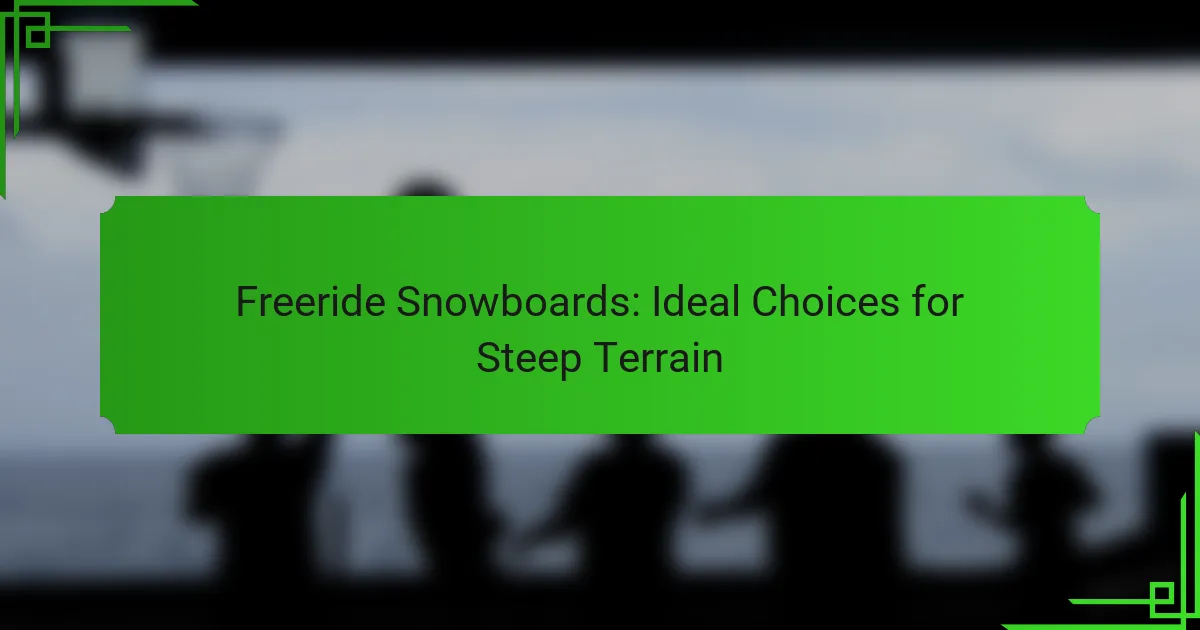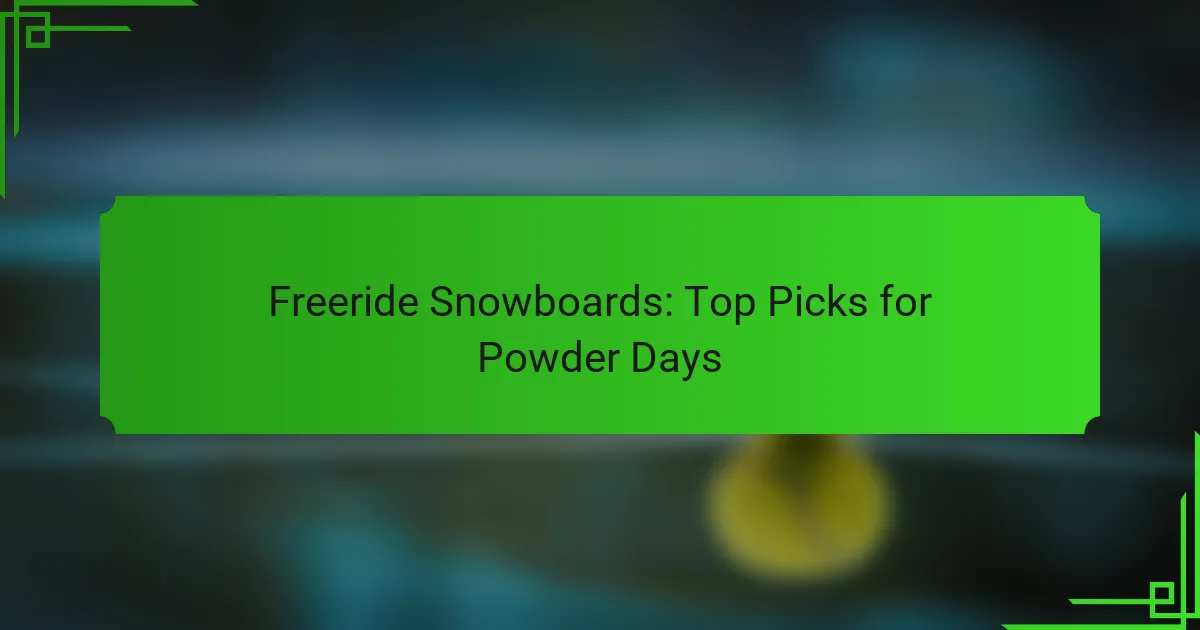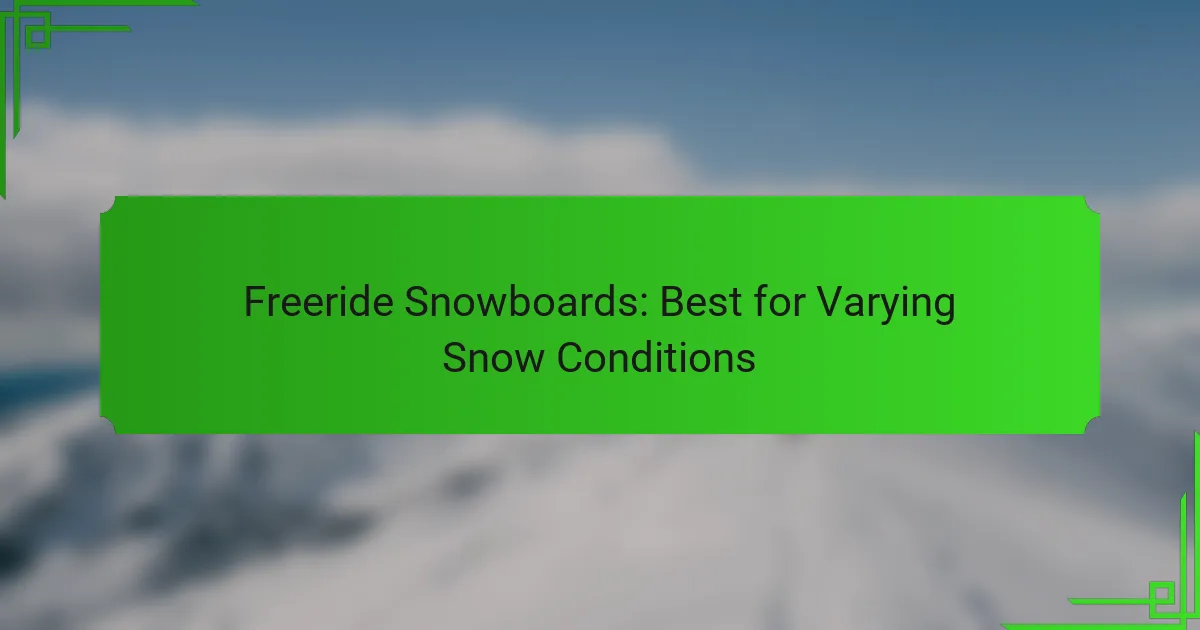What Are the Best Freeride Snowboards for 2023?
The best freeride snowboards for 2023 are designed for off-piste performance, stability, and versatility in various snow conditions. Key models include the Burton Custom X, Lib Tech T.Rice Pro, Jones Flagship, Salomon Ghost, and Ride Warpig, each offering unique features suited for different riding styles and preferences.
Burton Custom X
The Burton Custom X is a high-performance snowboard known for its precision and responsiveness. It features a directional shape and a stiffer flex, making it ideal for aggressive riding and carving on steep terrain.
This board utilizes Burton’s Flying V profile, which combines camber and rocker for enhanced float in powder while maintaining edge control on hardpack. Riders appreciate its lightweight construction, which aids in maneuverability.
Lib Tech T.Rice Pro
The Lib Tech T.Rice Pro is a versatile freeride snowboard that excels in both powder and park conditions. Designed in collaboration with pro rider Travis Rice, it features a hybrid profile that balances rocker and camber for optimal performance.
With its Magne-Traction edges, this board offers exceptional grip on icy surfaces, making it a reliable choice for varied conditions. The T.Rice Pro is also environmentally friendly, constructed with sustainable materials.
Jones Flagship
The Jones Flagship is built for advanced riders seeking stability and control in challenging terrain. Its directional shape and stiff flex provide excellent performance in deep snow and on steep descents.
This board incorporates a unique rocker-camber profile that enhances floatation while maintaining edge hold. Riders often highlight its durability and responsiveness, making it a top choice for backcountry adventures.
Salomon Ghost
The Salomon Ghost is designed for aggressive freeriders who demand precision and power. Its directional shape and medium flex make it suitable for both powder and groomed runs.
Featuring a Ghost Green Core, this board is lightweight yet strong, allowing for quick turns and stability at high speeds. The Salomon Ghost is particularly favored for its ability to handle varied snow conditions effectively.
Ride Warpig
The Ride Warpig is a unique board that combines a short length with a wide profile, making it ideal for playful riding in powder and park. Its versatile design allows for easy maneuverability and quick edge transitions.
This board features a hybrid rocker profile, providing a balance of float and stability. Riders appreciate its fun, surfy feel, making it a great option for those looking to explore off-piste terrain without sacrificing performance.
How to Choose a Freeride Snowboard?
Choosing a freeride snowboard involves understanding your riding style, board flex, length, and shape. These factors will help you select a board that enhances your performance and enjoyment on the slopes.
Consider your riding style
Your riding style significantly influences the type of freeride snowboard you should choose. If you prefer aggressive turns and high-speed descents, look for a stiffer board that offers stability. For more playful riding, a softer board may be better suited, allowing for easier maneuverability.
Additionally, consider whether you ride primarily in powder, on groomed runs, or in mixed conditions. Each environment may require different board characteristics to optimize your experience.
Evaluate board flex
Board flex refers to how much a snowboard bends under pressure. A stiffer board provides better edge control and stability at high speeds, making it ideal for aggressive freeriders. Conversely, a softer board is more forgiving and easier to turn, which can be beneficial for beginners or those who enjoy a more relaxed ride.
When evaluating flex, consider your weight and skill level. Heavier riders may require stiffer boards for adequate support, while lighter riders might find softer boards more manageable.
Check the board length
The length of a freeride snowboard affects its performance and handling. Generally, a board that reaches between your chin and nose is a good starting point. Longer boards provide better float in powder, while shorter boards are easier to maneuver.
As a rule of thumb, if you plan to ride mostly in deep snow, opt for a longer board. For mixed conditions or park riding, a shorter board may enhance your agility and control.
Assess the shape and profile
The shape and profile of a snowboard determine how it interacts with the snow. Freeride boards typically feature a directional shape, which is designed to perform best when riding in one direction. This shape helps with stability and control during descents.
Additionally, consider the board’s profile, which can be camber, rocker, or a hybrid. Camber provides better edge hold, while rocker enhances float in powder. Hybrid profiles combine both for versatility across different terrains.
What Are the Key Features of Freeride Snowboards?
Freeride snowboards are designed for off-piste and backcountry riding, emphasizing performance, stability, and control in varied terrain. Key features include directional shapes, stiff flex, high-performance edges, and lightweight materials that enhance the riding experience.
Directional shape
A directional shape means the snowboard is designed to be ridden primarily in one direction, which is ideal for freeriding. This shape typically features a longer nose and a shorter tail, allowing for better float in powder and improved stability at high speeds.
When choosing a directional snowboard, consider the sidecut radius and overall length, as these factors influence how the board handles turns and maintains speed. A board with a deeper sidecut can provide quicker turns, while a longer board may offer more stability on steep descents.
Stiff flex
Stiff flex in freeride snowboards provides enhanced responsiveness and control, especially on challenging terrain. A stiffer board allows for better energy transfer during turns, making it easier to navigate through variable snow conditions.
However, a stiffer flex can be less forgiving for beginners, as it requires more skill to maneuver effectively. Riders should assess their skill level and riding style when selecting a board, as a medium flex may be more suitable for those still developing their technique.
High-performance edges
High-performance edges are crucial for maintaining grip and control on hardpack and icy surfaces. Freeride snowboards often feature sharper, more durable edges that enhance carving ability and provide stability during aggressive turns.
Look for boards with features like serrated edges or additional edge technology, which can improve performance in challenging conditions. Regular maintenance, such as tuning and sharpening the edges, is essential to maximize their effectiveness.
Lightweight materials
Lightweight materials, such as carbon fiber or advanced composites, are commonly used in freeride snowboards to reduce overall weight without sacrificing strength. This reduction in weight helps riders maneuver more easily and reduces fatigue during long days on the mountain.
When evaluating a snowboard, consider the balance between weight and durability. While lightweight boards can enhance performance, they should also be robust enough to withstand the rigors of off-piste riding. Look for models that offer a good combination of both attributes for the best experience.
What Are the Price Ranges for Freeride Snowboards?
The price ranges for freeride snowboards typically vary based on the brand, materials, and technology used. Generally, you can find options starting from under $500, with mid-range models priced between $500 and $800, and premium models exceeding $800.
Entry-level options under $500
<p.Entry-level freeride snowboards under $500 are ideal for beginners or casual riders looking to explore the sport without a significant financial commitment. These boards often feature basic construction and materials, making them suitable for learning and occasional use.
When selecting an entry-level board, look for models that offer a forgiving flex and stability. Brands like Burton and K2 often provide solid options in this price range, ensuring you get decent performance without breaking the bank.
Mid-range options $500-$800
Mid-range freeride snowboards priced between $500 and $800 offer a balance of performance and durability, catering to intermediate riders who want to enhance their skills. These boards typically incorporate better materials and advanced technologies, resulting in improved responsiveness and control.
In this range, you can find boards that excel in various conditions, from powder to groomed runs. Popular brands such as Lib Tech and Ride offer models that provide a good mix of versatility and performance, making them a great choice for those looking to progress.
Premium models over $800
Premium freeride snowboards priced over $800 are designed for serious enthusiasts and professionals seeking top-tier performance. These boards often feature high-end materials, advanced construction techniques, and specialized designs that enhance performance in challenging conditions.
Investing in a premium model can significantly improve your riding experience, especially in backcountry or off-piste terrain. Brands like Jones and Nitro are known for their high-quality offerings, which can provide exceptional stability and edge control, making them worth the investment for dedicated riders.
Where to Buy Freeride Snowboards in the US?
You can purchase freeride snowboards in the US at various retailers, both online and in physical stores. Popular options include specialized snowboard shops, major sporting goods stores, and e-commerce platforms that offer a wide selection and competitive pricing.
Online Retailers
Online retailers provide convenience and often a broader selection of freeride snowboards. Websites like Amazon, Backcountry, and Evo allow you to compare prices and read customer reviews. Look for retailers that offer free shipping and easy return policies to ensure a hassle-free shopping experience.
Local Snowboard Shops
Local snowboard shops are excellent for personalized service and expert advice. Staff members are usually passionate about snowboarding and can help you find the right board based on your skill level and riding style. Supporting local businesses can also help you discover unique brands that may not be available online.
Sporting Goods Stores
Major sporting goods stores like Dick’s Sporting Goods and Academy Sports + Outdoors typically carry a selection of freeride snowboards. These stores often have seasonal sales, making it a good idea to shop during the off-season for better deals. Check for in-store demos or events to test boards before purchasing.
Second-Hand Options
Buying second-hand freeride snowboards can be a cost-effective way to get quality gear. Websites like Craigslist and Facebook Marketplace often have listings from local sellers. Always inspect the board for damage and ask about its history to ensure you’re making a sound investment.






